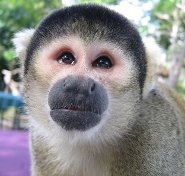 The Bolivian squirrel monkey (Saimiri boliviensis), which is also known as a black-capped squirrel monkey or black-headed squirrel monkey, is an energetic, social monkey that lives in South America. Bolivian squirrel monkeys can live in a variety of habitats, but prefer tropical rainforests that occur between sea level to 1500 meters, or 4920 feet, above sea level. These monkeys can be found in Bolivia, Brazil, and Peru. Bolivian squirrel monkeys spend most of their time up in the tree canopy, but do occasionally make their way down to the forest floor in search of food.
The Bolivian squirrel monkey (Saimiri boliviensis), which is also known as a black-capped squirrel monkey or black-headed squirrel monkey, is an energetic, social monkey that lives in South America. Bolivian squirrel monkeys can live in a variety of habitats, but prefer tropical rainforests that occur between sea level to 1500 meters, or 4920 feet, above sea level. These monkeys can be found in Bolivia, Brazil, and Peru. Bolivian squirrel monkeys spend most of their time up in the tree canopy, but do occasionally make their way down to the forest floor in search of food.These primates have an average body length of 27 to 32 centimeters, about 10.5 to 12.5 inches. It weighs on average 950 grams or about 2 pounds. The Bolivian squirrel monkey’s coat is a mixture of gold and tan hues and is tipped in black. The coloring around its mouth and nose is black or dark brown, while the fur surrounding its eyes is white.
One of the main ways to distinguish the Saimiri boliviensis group from other squirrel monkeys is by this white mask around its eyes. The mask of a Saimiri sciureus monkey has a dramatic V shape between its eyes, while a Bolivian squirrel monkey’s white mask has a more rounded shape.
These little monkeys feed on a variety of things, including seeds, insects, berries and fruits. Bolivian squirrel monkeys have also been known to dine on small animals, such as birds or bats, and also on eggs. The Bolivian squirrel monkey is a gregarious, social animal that likes to live in large groups of typically 40 to 50 animals, although larger groups of 200 or more do occur. Unlike some animals, more than one male is allowed to live with the group, with young male monkeys often remaining with their family group until they reach the age of four or five. After that, young males usually leave the family group to live with other bachelors. Females usually remain with their family groups.
Bolivian squirrel monkeys typically have one baby, and the females will babysit each other’s infants. These monkeys can live to be 30 years old. Bolivian squirrel monkey predators include harpy eagles and snakes, as well as humans, who not only hunt the monkeys for meat, but also capture them to sell as illegal pets and for use as laboratory research subjects. The Bolivian squirrel monkey’s current status is of least concern on the IUCN’s Redlist, as it is still quite common in the wild. Currently, the main threat to the Bolivian squirrel monkey’s population is habitat destruction from logging and clearing for agricultural use.
Picture of the Bolivian Squirrel Monkey by Ryan Hyde, licensed under the Creative Commons Attribution-ShareAlike 3.0 License.
Keywords: black
Which zoos have them?
Artis (Netherlands)The Black-headed squirrel monkey, bolivian squirrel monkey is listed as Least Concern. Does not qualify for a more at risk category. Widespread and abundant taxa are included in this category, on the IUCN Red List of Threatened Species
Namings for the Bolivian squirrel monkey
A young / baby of a Bolivian squirrel monkey is called a 'infant'. A Bolivian squirrel monkey group is called a 'troop, barrel, tribe or cartload'.Some facts about the
Bolivian squirrel monkey
Adult weight : 0.615 kg (1.353 lbs)
Maximum longevity : 30 years

Custom Search